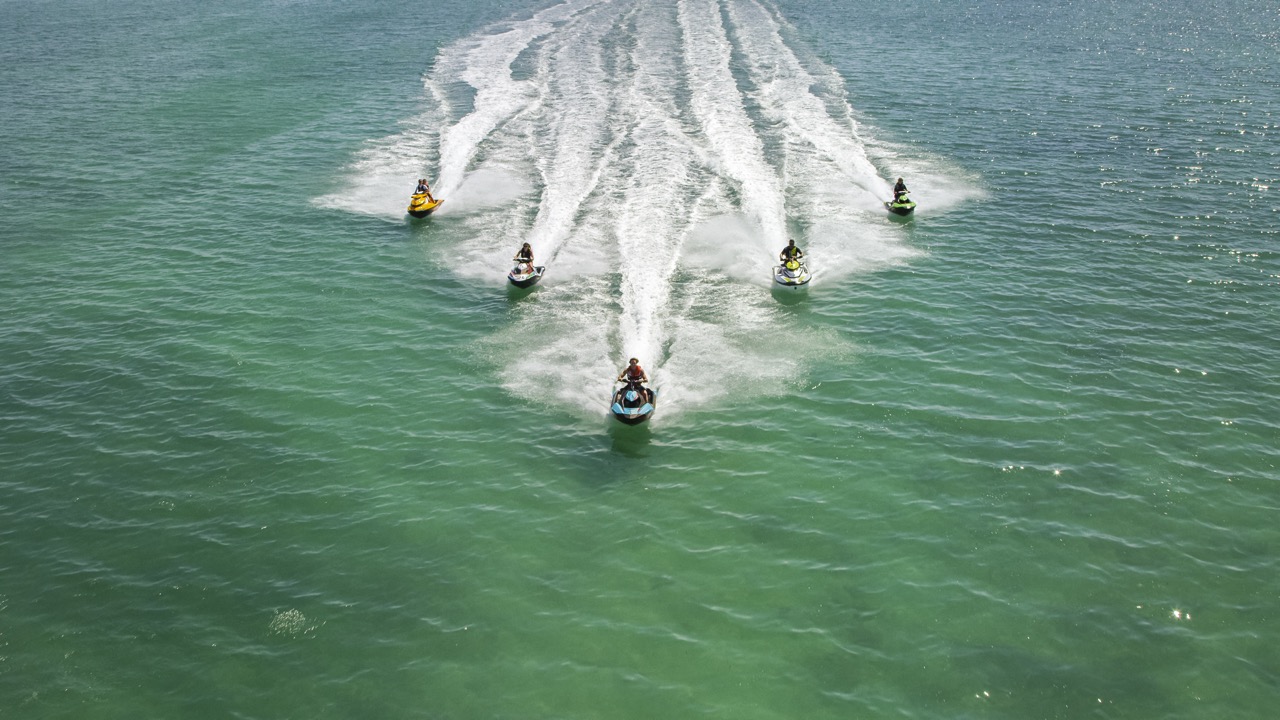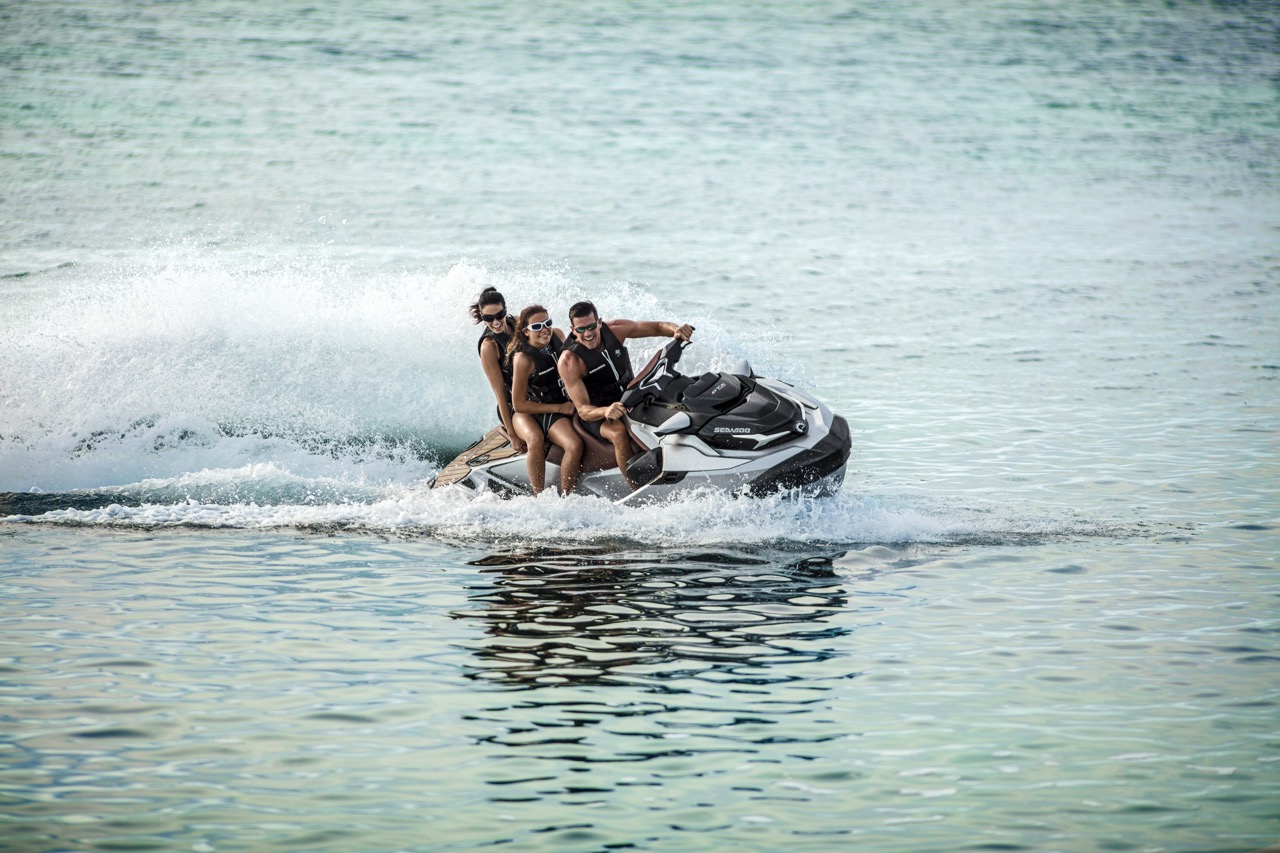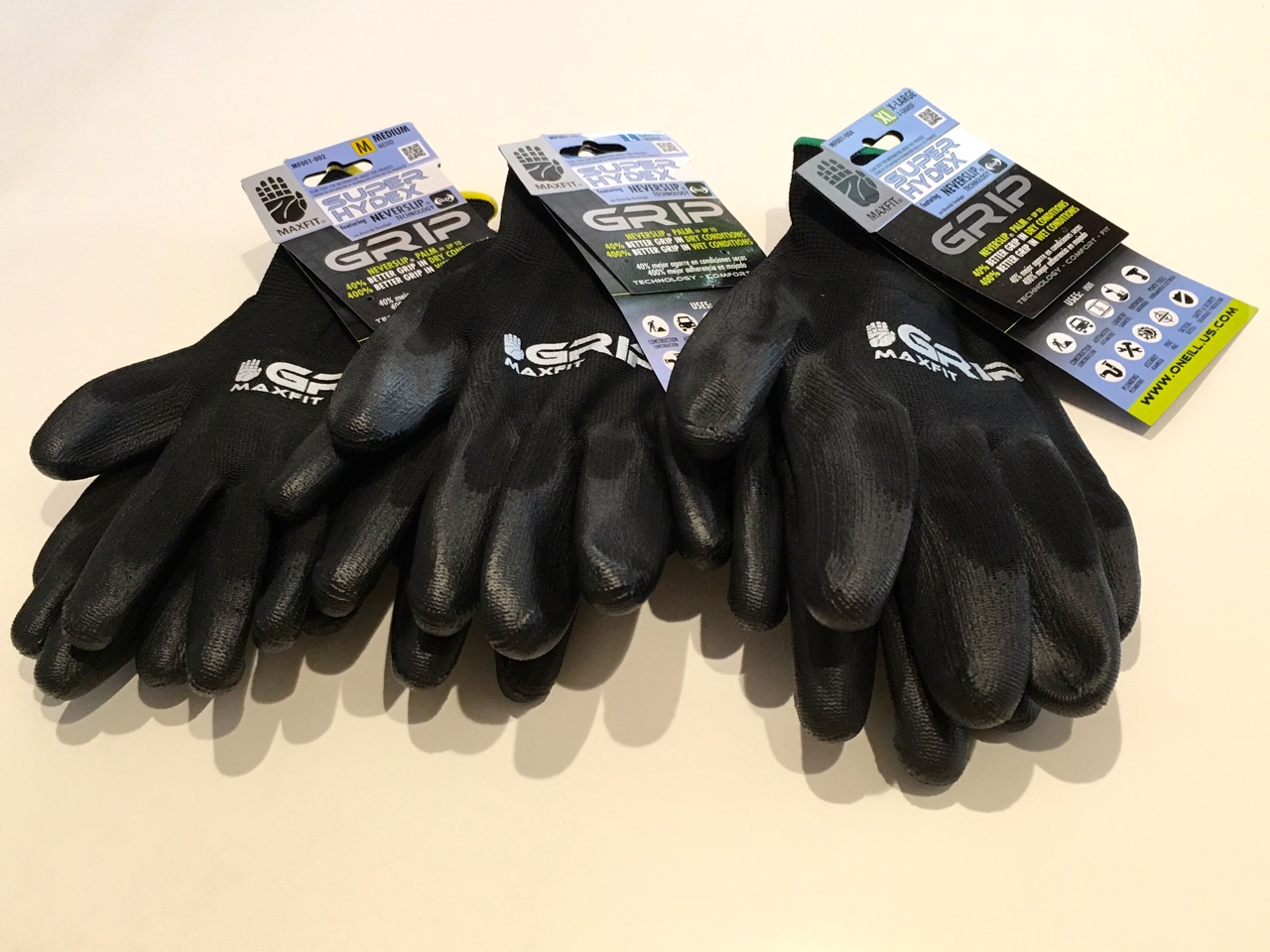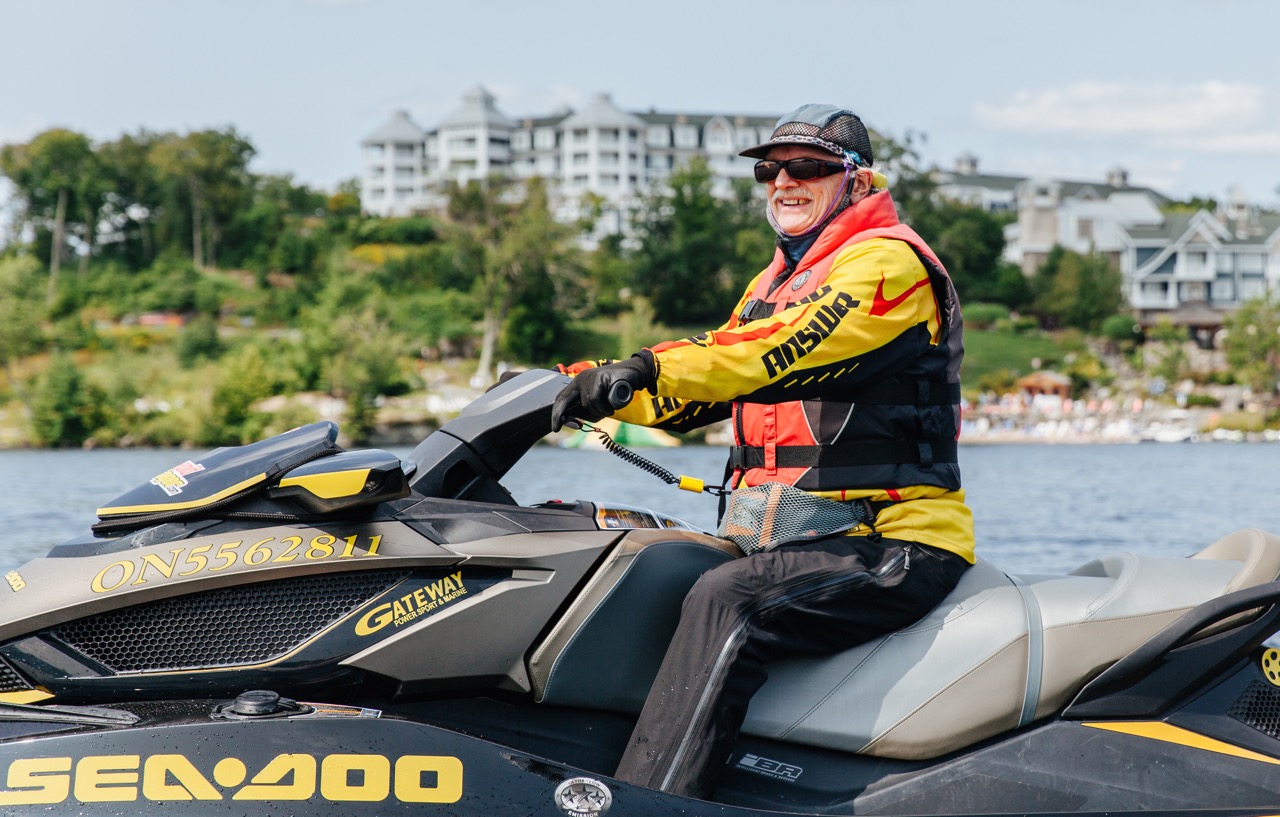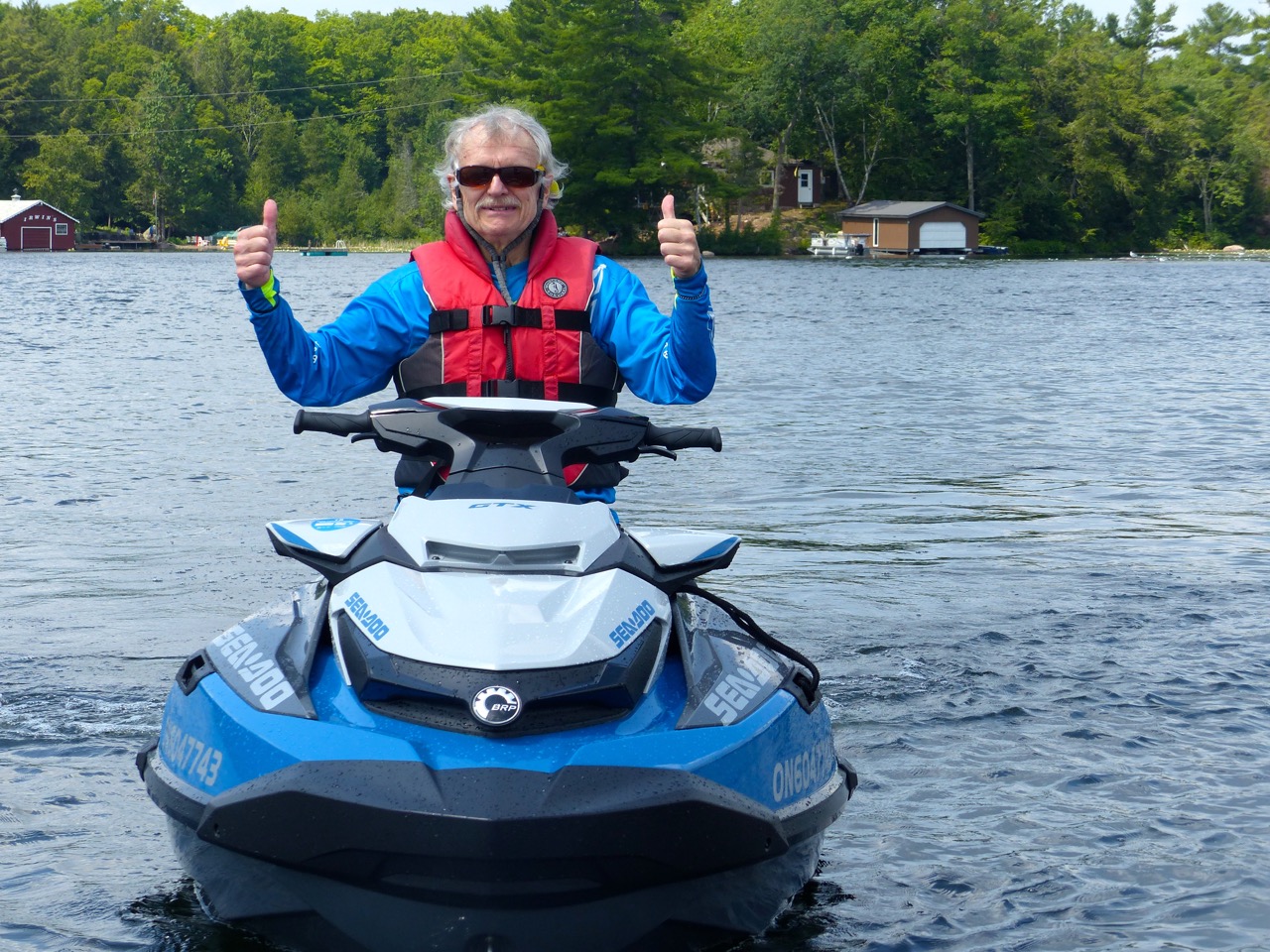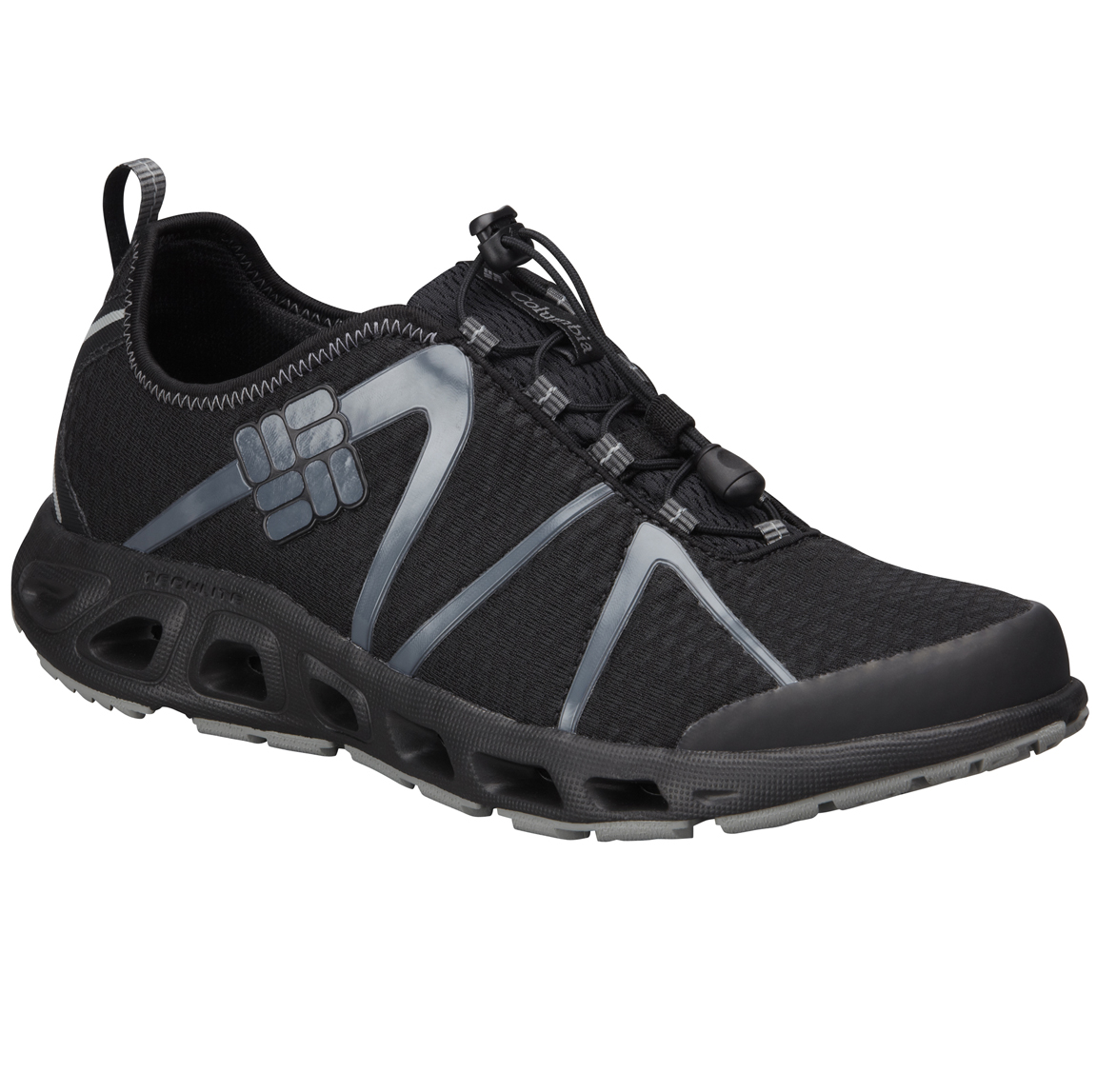PWC Riding Gear For Newbie Sea Doo Rides…
Related: Top 10 Ride Spoilers
Why are beginners riding protection tips important? Because they can make the difference between a great first jet ski ride and one that’s a painful learning experience on your PWC adventure.
Nothing beats the refreshing freedom of skimming across clean, clear waters on a hot summer day, with a light breeze whipping your hair and cooling your skin. Or the sheer exhilaration of riding a personal watercraft for the first time!
Like most of us, your first impression of Sea Doo riding probably came from personal watercraft images. You know, the ones in social media, boating magazines and manufacturer brochures. The ones that typically portray smiling jet ski riders, wearing nothing more than life vests and bathing suits.
Real Ride Issues
But in the real world, riding totally carefree all day isn’t usually the best way to go. You can totally imagine yourself carving the waves on that Sea Doo watercraft for many hours. But it’s all too easy to forget that constant exposure to blazing sun can be painful later. That’s because the cooling effects of water and breeze can disguise the normal early warning signs for too much sun on your skin.
Similarly, did you know you could become dehydrated on a steamy hot day even though you’re surrounded by water? So it’s also important to drink lots of (non-alcoholic) fluid throughout your ski ride.
And what about that cooling breeze? Several hours of being wind-whipped can be hard on your skin. Not to mention making the air temperature around you feel cold.
These are just three reasons why I highly recommend that jet ski novices and newbies start off well protected with good PWC riding gear. And why you should take my beginners riding protection tips to heart. After all, it’s about what you can do to help make your first fun on the water even more memorable – for all the right reasons. So let’s start with lifesavers…
Beginners Riding Protection Tips
Life Jackets
In most jurisdictions, boaters are required to carry a life jacket, life vest or personal flotation device (PFD) for every person on board. Most are stowed away, not actually worn, which is a major contributing factor to boater drownings.
Fortunately, always wearing a PFD while riding is customary among jet ski riders. In part, this is because there’s not much room to store them on board. But it’s also because you are much more likely to fall off a PWC than a boat. But your life jacket also serves two other important purposes for Sea Doo riding.
One, your PDF provides a fail-safe shut off for your PWC if you fall off. With the starter key tether cord attached to the handy clip on your life vest, it will disconnect when stretched, shutting off the PWC engine. Thus, your personal watercraft can never get away from you or leave you stranded in the water.
Two, your PFD provides your first line of protection from the elements. It protects your upper chest, shoulders and upper back from sunburn and also provides a windbreak for your torso. Your life vest doesn’t cover everything, but it’s a good start.
The rest is up to you. You can enhance this basic protection by assembling a personal kit to carry with you. Here are some suggestions about what it should include…
Sun Lotion
Choose a top sun lotion or cream, with an SPF suitable for your skin type and sensitivity. The higher the better as far as your skin’s concerned! Whatever your choice, it should definitely be water resistant. But understand clearly that no sun lotion can withstand exposure to water for long. So the only sure way to avoid suffering a painful burn on the water is to re-apply it often to exposed skin. Even on those hazy days when burning sun rays can still penetrate to your skin.
And remember when you’re touring on any jet ski, PWC or waverunner, that you’re essentially locked into a seated position for the day. This means that the most vulnerable parts of your skin to burning are:
- the back of your hands (which are always on the handlebars) & arms;
- the tops of your thighs and the backs of your ankles & calves (due to the seated position);
- and your face, back of neck and ears.
Meanwhile, don’t forget that the water around you also acts as a reflecting magnifier of sunrays. This magnification effect increases your chances of getting burned. Unfortunately, no personal watercraft has an overhead canopy or other built in operator protection like many boats do. So your best bet is to lather on the sun lotion!
Riding Gloves
Experienced jet ski riders quickly learned that sun lotion alone doesn’t always do the trick. The best way to protect the backs of your hands from burning is by wearing a pair of riding gloves. Gloves also have the added plus of providing extra grip on the handlebars. They also protect your palms and fingers from possible blisters that can occur because your hands aren’t used to the pressure and friction of hanging on. PWC novices and newbies can get started with any pair of tight gloves like those used for cycling or paddling.
Peaked Hat
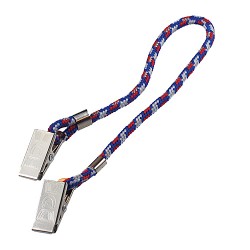 A peaked cap not only protects your head and forehead from sunburn, it can help keep long hair out of your eyes. The trick is keeping the hat on while riding, because the wind tends to catch the peak and flip it off. So you need a cap that can be worn tight.
A peaked cap not only protects your head and forehead from sunburn, it can help keep long hair out of your eyes. The trick is keeping the hat on while riding, because the wind tends to catch the peak and flip it off. So you need a cap that can be worn tight.
It’s also a good idea to use a short tether with alligator clips on either end. Fasten one to your cap and attach the other to your life vest. This way, if your hat does come off while riding, you won’t lose it in the water.
If neither of these is workable, try wearing the cap with the peak at the back so the wind won’t be as likely to catch it. At least your scalp will be protected from burning – it’s hard to apply sun lotion to your head! At the very least, take a ball cap with you and always put it on when stopped or floating. After all, some protection is better than none!
Long Sleeve Shirt
Sometimes, despite best efforts, you can feel your skin burning or sense you’re getting too much sun. This is the time to put on a long sleeve shirt, preferably one that’s made of quick-drying material like Dri-Fit. This will protect your arms and shoulders from frying, without being too hot to wear. A long sleeved shirt can also be beneficial if the wind gets too strong or cold.
Eye Protection
 Pay close attention to protecting your eyes while Sea Doo riding. The combined glare from the sky and off the water can make seeing difficult. It may potentially even cause some eye damage, including burned eyelids.
Pay close attention to protecting your eyes while Sea Doo riding. The combined glare from the sky and off the water can make seeing difficult. It may potentially even cause some eye damage, including burned eyelids.
That’s one reason why wearing sunglasses is essential. Another is to deflect away any breeze or wind generated by your forward momentum. To say nothing of keeping any flying insects from hitting you in the eyes.
Your best bet is wrap-around style sunglasses that also provide some side protection. They should fit snuggly, but also secure them with an eyeglass strap at the back, preferably one that floats just in case they go overboard. At some point, consider investing in a pair of floating sunglasses.
Once you’ve made the decision to do more jet ski riding, you may want to invest in a good pair of riding goggles.
Foot Protection
The tops of your feet and ankles are particularly vulnerable to sunburn while Sea Doo riding. They also may be the hardest location to keep sun lotion working long since they may get wet most often. That’s why I recommend wearing some kind of water shoes while riding. This quick drying and water shedding footwear can also be helpful in protecting the bottoms of your feet while wading in the water or walking on uneven ground when ashore. Beginners may want to start with an old pair of running shoes or Crocs.
Carrying this personal protection PWC riding gear can certainly make your Sea Doo ride more enjoyable. And prevent unexpected discomfort that can set in after your incredible day of the water. In addition, I also suggest you carry a few other items of jet ski riding gear: a fully charged cell phone, proper ID, credit card & cash, and a towel. For more, check out my weather protection advice.
Now, don’t forget your bottle of water and you’re really ready for your first personal watercraft ride!
If you enjoyed this post, check out my other riding tips.
The tips and advice in this article are the opinions of the author, may not work in every situation and are intended only for the convenience and interest of the reader, who has the personal responsibility to confirm the validity, accuracy and relevancy of this information prior to putting it to their own use.

